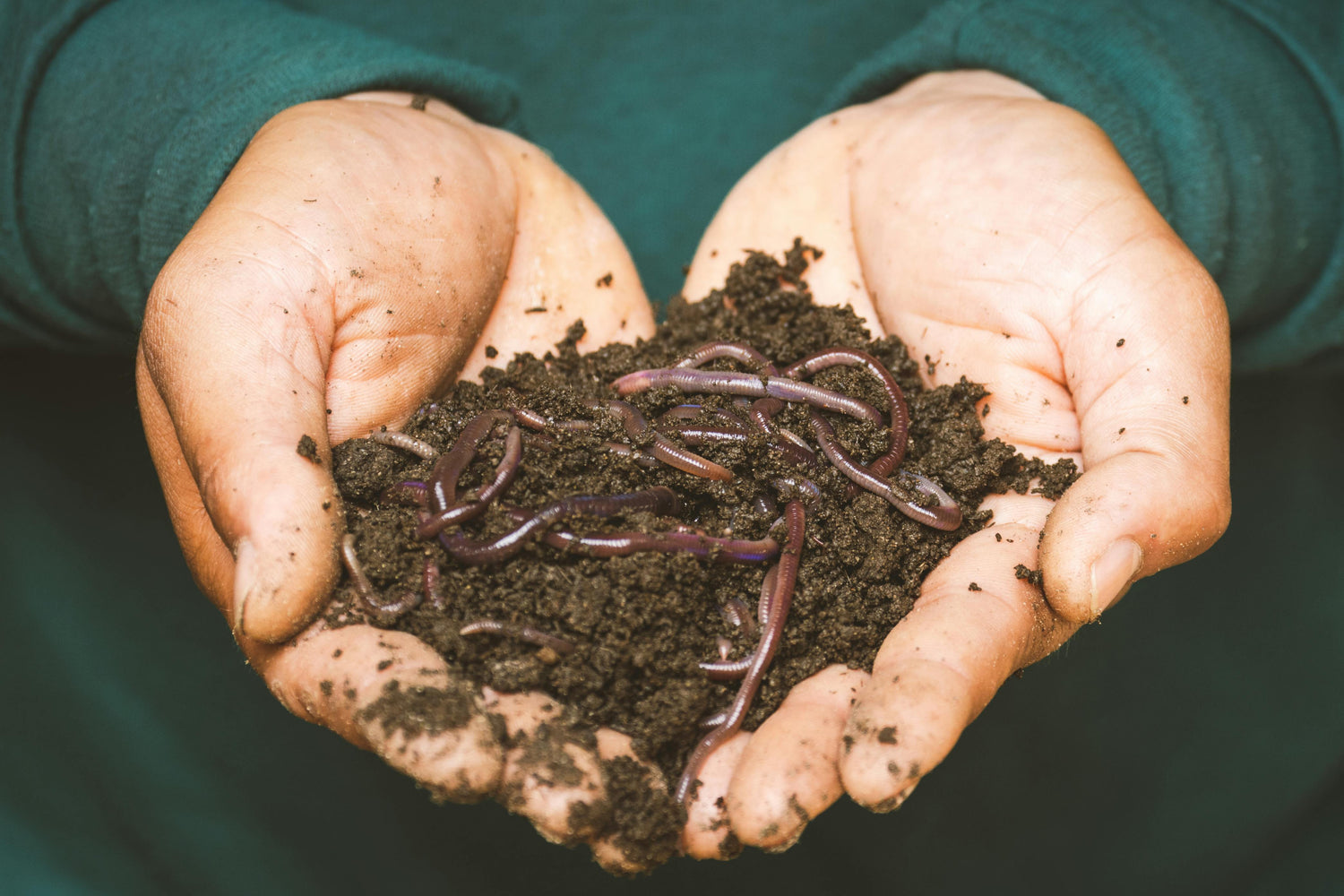Table of Contents
Guide to the 6 Most Common Worm Bin Problems (and How to Solve Them!)
1. Improper moisture
2. Improper temperature levels
3. Lack of air circulation
5. Unregulated pH levels
6. Too much protein
Can disease impact worms?
Symptoms of worms dying:
1. Lethargic worms
2. Low consumption of food
3. Foul odor
Signs that the worms are fine
1. Presence of Cocoons
2. Increasing food consumption
FAQs
Should I remove dead worms from my worm bin?
Will worms die in a compost bin?
How long do worms live in a worm bin?
How do you know when a worm is dying?
Conclusion
Having worm bin problems? According to the Government of California, it's the worm's gut which facilitates the process of vermicomposting. Hence, if there is any problem in your bin that impacts worm health, the entire process of vermicomposting is compromised.
The post below will help you in this regard as it covers issues like the most common bin problems that can occur, how worms die, and how to solve such problems before they become fatal for the worms.
Guide to the 6 Most Common Worm Bin Problems (and How to Solve Them!)
Below are the 6 most common issues that can impact your worm bin.
1. Improper moisture
Maintaining moisture in your worm bin is a tricky job. Proper regulation of moisture is crucial since a worm's body consists of 75% water. They can only maintain body moisture levels by living in habitats with the right amount of moisture.
- Too much moisture
Worms breathe through their skin. If the bin contains too much water, it can hamper the breathing of worms which can suffocate them. Therefore, control every water source through which water enters the bin.
Most beginners think the only water source in a worm bin is the water they sprinkle on the bedding.
But, that's not true!
Foodstuffs with a higher water content can also release water, drastically increasing the moisture content in the bin.
You might also wonder, how I would know if my bin has too much moisture?
Ideally, the bedding and the contents of the bin should be moist, and the texture should be similar to a wrung-out sponge. However, if you notice standing water that isn’t being absorbed by these materials, it indicates high water content.
If that’s the case, worry not!
Try the solutions below.
How to solve it?
You can improve the situation in a couple of ways.
- The first thing you can do is add more dry bedding to the bin. Spread it out, and it will absorb the excessive standing water present.
- The second solution you can try is tilting the bin on the side to move the excess water to the side. Thereafter, you can extract it using a pipe or a scoop.
The best way to prevent this problem from occurring again is to use a worm bin with at least a few drainage holes at the bottom to let the standing water out.
- Too little moisture
Worms can only drink water by absorbing it through their skin. When your worm bin is too dry, worms can die of thirst. Fortunately, this problem is easy to detect and fix.
Pick up some organic matter from your worm bin and squeeze it. Ideally, a few water drops should come out. If not, the worm bin is too dry.
How to solve it?
The best way to fix this problem is to add more water to your worm bin. But don't just fill a bucket and pour it. You have 2 options:
- Spray bottle
- Sprinkling water by hand
When using either of these, ensure you cover a fairly large area to spread moisture evenly.
2. Improper temperature levels

According to a report published by North Carolina State University, the ideal temperature of a worm bin is between 55°F to 80°F. So, if you’re wondering at what temperature do worms die, the answer is any significant deviation from this range can prove fatal for worms.
- High temperature
When the temperature of the worm bin increases significantly beyond the range mentioned above, 3 problems can occur. These are:
- Overheating of worms
- Drying out of organic matter in the bin
- Worm fatalities
The best way to avoid this problem is to use a thermometer to measure bin temperature daily. If you notice a significant rise, correct the situation by trying out any of the solutions below.
Must Read : Red Wiggler Worms 101: Everything You Need to Know About Eisenia Fetida
How to solve it?
The ways to solve this problem are as follows:
- Change the location of the bin to keep it in a cool , dark place. Ensure the bin is in shade throughout the day.
- Use a fan to cool down the exteriors of the worm bin which will also cool down the interiors eventually.
- Place a wet towel on top of the worm bin after removing the lid.
-
Insert cold water bottles in the organic matter amidst the bin. However, when the bottles are inside, ensure you monitor the temperature to avoid drastic temperature reduction.
- Low temperature
If the worm bin temperature reduces significantly below the above-mentioned range, worm activity will reduce, which will also lead to less reproduction. Needless to say, the process of vermicomposting will slow down and come to a halt. Worms will go into survival mode first and can eventually die as well.
How to solve it?
Some of the best ways to increase worm bin temperature include:
- Insulate the worm bin from the cold exterior temperature by wrapping it up with blankets or cardboard.
- Place a space heater nearby and periodically monitor the worm bin temperature to ensure it doesn't get too hot.
- Move the worm bin to a location that is more enclosed to avoid the effect of exterior temperature.
- Feed worms food that is high in nitrogen like banana peels, coffee grounds. When such food gets broken down by worms it generates heat which increases the worm bin temperature.
3. Lack of air circulation
Oxygen is needed by any living creature including worms, to survive. Lack of air circulation leads to a lack of oxygen, which can prove fatal for worms. However, this problem is easy to detect.
Usually a worm bin has an earthy smell. When oxygen is in short supply it will have a foul unpleasant odor. If you notice such a smell try out the solutions below.
How to solve it?
The solutions to this problem are pretty simple.
- Move the organic matter every week to ensure it doesn't form clumps. Moving it around also aerates the bin.
- Ensure the lid and the bottom have holes to let the air in.
4. Improper food supply
Worms need proper food supply. Too much or too little food can cause problems for worms. Therefore, you need to get the food proportion right. Below, we will cover the solutions to both these issues. As a rule of thumb, it's best to feed worms according to their body weight. A pound of worms can eat a pound of food daily.
- Too much food
Overfeeding worms can result in problems like:
- Foul odor
- Worm bin contents turning acidic
- Moisture levels increasing
- Pest infestation
- Worms becoming sick
Watch out for any of these signs, and if you notice any, try the solution below.
How to solve it?
There are a few ways to avoid overfeeding:
- Feed worms food equal to their body weight as described above.
- Feed worms only when the previous food is over.
- Depending on the worm species, their population can double every 3 to 6 months. Instead of directly doubling the food supply after this duration, gradually increase the food supply and follow the above highlighted solution.
- Too little food
Simply put, under-feeding can make them starve to death. Even if the extent of under-feeding is less it can lead to other problems like lethargic worms. In the absence of proper food supply, they aren't likely to reproduce at the same rate which stagnates their population and slows down the vermicomposting process.
Apart from lethargy, if the feed doesn't even last for a day it indicates that you are feeding them less.
How to solve it?
At the start, since you’ll be adding worms by weight to the bin, feed them food that is equal to their body weight everyday. Thereafter observe whether the food supply lasts a day or not and increase or decrease accordingly.
5. Unregulated pH levels

Ideally, the pH level of the worm bin should be around 6.5 which is slightly acidic. However, as you add food to the bin and the worms start producing worm castings, the pH level of the worm bin can change. Any extreme changes in pH levels can lead to problems. We will cover such cases below, along with their solutions.
- Higher pH level:
The best way to detect high pH levels is using a pH meter. There are a few ways to increase the acidity to lower down the pH level.
How to solve it?
Opt for any of the solutions highlighted below to lower the pH level.
- Feed acidic foodstuffs to worms like coffee grounds, citrus peels, or bread soaked in vinegar.
- Many times, when the bin contents turn dry, the pH level goes up. Therefore, fine tuning the moisture levels in the bin, helps.
- Lower pH level:
Lower pH levels indicate that the contents of the worm bin are too acidic which isn’t conducive to worm health.
How to solve it?
The best solutions to increase the pH level include:
- Adding peat moss to bedding.
- Adding crushed eggshells to increase the pH level.
- Aerating the bin contents to increase the pH level.
6. Too much protein
Another mistake that many vermicomposters make is they inadvertently cause protein poisoning among worms. Unfortunately, this problem is very difficult to detect until the worm population starts dwindling. The most likely causes of this problem include:
- Overfeeding
- Excessive moisture
- Low calcium in worm diet
The first one is the most likely cause. While worms will eat the extra food but it will take them more time to do so which provides enough time for food to ferment. Consuming fermented food causes gasses to build up and since worms can’t release gasses, eventually the gasses rupture their digestive tracts causing their death.
When such worms die, their body often resembles a string of pearls because of the rupture. If you notice a dead earthworm whose body resembles strings of pearls you need to act fast because most worms would have consumed the fermented food by then.
Must Read : Make Your Own Black Gold (or why worm poop is so great)
How to solve it?
You can undertake a few steps to deal with protein poisoning.
Step 1: Remove all food from your worm bin.
Step 2: Add new bedding to the worm bin. The ratio should be 1:1. It means you need to add as much new bedding to the bin as the old one. Mix it well with old bedding but additionally create a 3 inch layer of new bedding on top.
Step 3: Sprinkle some water on new bedding and add some fresh food to the bedding.
Step 4: Lastly, add some crushed eggshells to the worm bin to provide worms with more calcium.
In future, strictly avoid overfeeding. If the food lasts for more than a day, remove it and add fresh food to ensure worms don’t consume fermented food.
If you too are wondering why did my worms die, one of these is the likely cause. While we have covered the most common problems above, it's time to understand if disease can plague your worm bin.
Can disease impact worms?
Usually not. In fact there are reports like this one from the Connecticut Government, which state that worms reduce spread of disease in soil and plants, while aiding plant growth. Another report stated that earthworms can even be possibly immune to diseases like COVID-19. Point being, worms dying in worm farms can’t be attributed to diseases in most cases.
Symptoms of worms dying:
Always watch out for these symptoms to save worms from dying.
1. Lethargic worms

In a healthy worm bin, worms usually surface to consume the food and then move back to bedding. Therefore, plenty of worm movement is visible when you open the worm bin. In case, the worm movement is slow or absent that indicates trouble in the worm bin. So, watch out for lethargic worms.
2. Low consumption of food
Keeping track of food consumption in the worm bin is a must. If everything is fine, the food consumption should accelerate because of the growing population. Fluctuating or low food consumption is the first sign that something is not right.
3. Foul odor
Earthy odor indicates all is good in the worm bin. According to this report, any pungent or intense odor indicates a problem with the worm bin. Usually, this means the pH level is low, and the contents are acidic. If you don’t act fast it can impact the worm's health.
Signs that the worms are fine
Similarly, there are a couple of indicators that mean conditions in your worm bin are fine.
1. Presence of Cocoons
The biggest indicator that everything is fine in your worm bin is the presence of cocoons.
Therefore watch out for:
- Cocoons in the worm bin. Cocoons look similar to small lemons, but their shape can vary.
- Usually, you won’t just spot 1 or 2 cocoons in your worm bin but multiple such cocoons.
- Within a few weeks of spotting the cocoons, you’ll notice smaller worms in the bin, which are shorter and also paler.
2. Increasing food consumption
Food consumed by worms should constantly go up. You, too, need to gradually increase the feed to ensure it lasts at least a day. If that’s happening, conditions inside the worm bin are right.
Must Read : Red Wigglers or Nightcrawlers: Which is Better for Vermicomposting?
Conclusion
Starting a worm bin and sustaining it isn’t that difficult if you know what to do. Using the guide above, you can avoid the most common mistakes to ensure you have a thriving worm bin. Once you keep the above few tips in mind, instead of worrying about the worms, you’ll just have to think about what to do with the compost.
Now that you’re aware of how do worms die and how to avoid that, start your own worm bin by getting purebred red wigglers by clicking here!
Sources:




1 comment
Christine Comerford
Hello, I’ve had 3 worm bins in raised beds in our backyard, for about 2 years. They mostly do great, but we periodically have ant problems. Diatomaceous earth around the beds works sometimes, but not consistently. Any advice? During the crazy hot months, I put several ice cubes on top of their cardboard/blankets, to help keep them cool and hydrated. Thanks!
Leave a comment
All comments are moderated before being published.
This site is protected by hCaptcha and the hCaptcha Privacy Policy and Terms of Service apply.